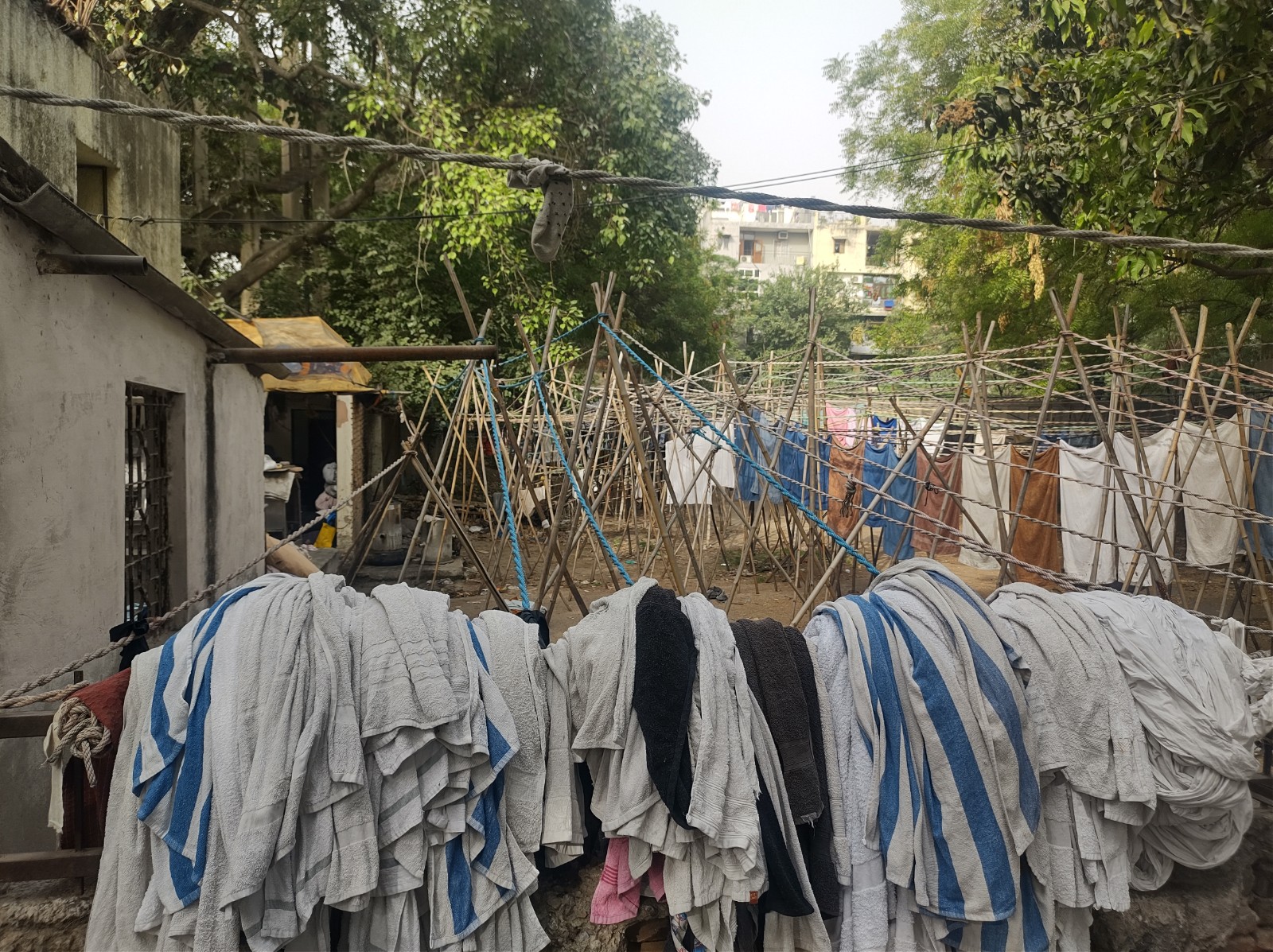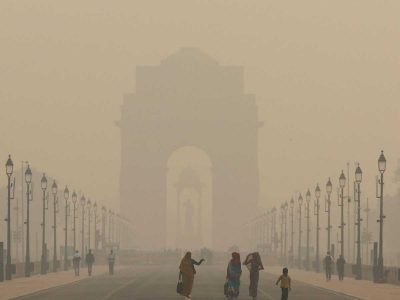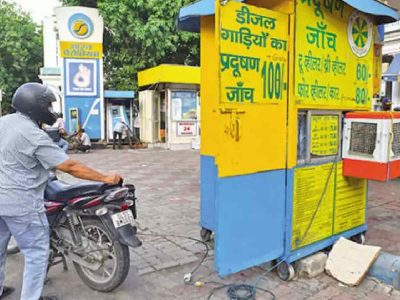It’s seven in the morning, and the hot summers have already made the sun almost intolerable. As we enter the gates of Kailash Colony dhobi ghat, we see men washing clothes on a cement block — each of them lined up next to the other.
Kishore Kumar’s ‘Chala jaata hoon, kisiki dhoon mein’ plays on the speaker inside, providing some entertainment to the dhobis. “We do this for several hours a day, might as well listen to some songs and enjoy the work”, says Vishal, one of the supervisors at the ghat.
At first glance, the ghat looks chaotic. But once you enter, you see that there is a method in the madness in the way clothes are washed, sorted and ironed. First, they are soaked in bathtubs, then they are loaded in large washing machines that can bear the load of 100 kg of clothes before they are tumbled into large cylindrical dryers. For emergencies, the ghats are also equipped with modern-day washing machines and dryers.
The dhobi ghats cater to hotels, gyms, beauty parlours, salons, event management companies and individual customers. Long clotheslines define the boundaries of the dhobi ghat as they optimise time and space.
“We have 15 machines each of which washes six to seven rounds of clothes every day. We have enough space to hang these clothes to dry in this small area of barely three acres. It’s possible because we have long clotheslines in every possible space that can be utilised”, adds Vishal.
Earlier, the dhobis used to wash the clothes on a rock, squeeze them dry by hand and then hang them to dry on the “timeless” clotheslines. However, with the development of technology, these ghats have adapted to modern-day machines, making the task much easier. But, despite evolving laundry mechanisms, the business that solely depends on water, is always grappling with some kind of water problem.
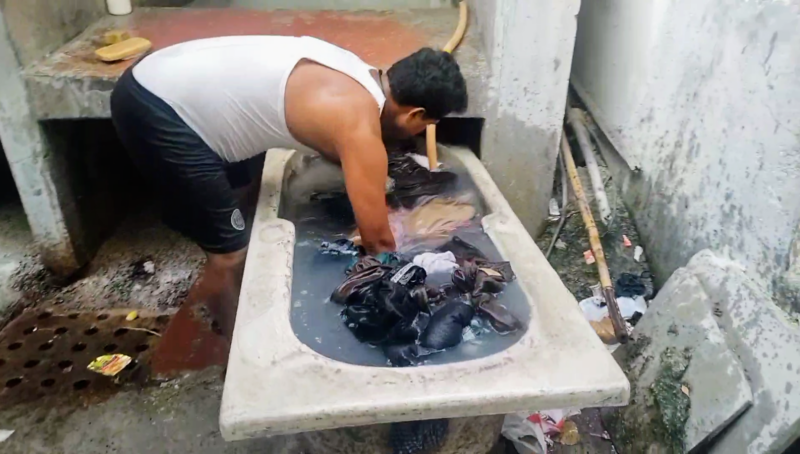
Water woes
“We were washing clothes at the ghat, and suddenly the water supply stopped. We were still left with five to seven more rounds of clothes for each machine. We had no update from the supervisors or the Delhi Jal Board about when we can expect the water supply to resume. Delivery timelines were compromised, and we incurred a significant loss for the week”, says Jawahar, a traditional dhobi at the Kalkaji ghat who has adapted well to the new technology.
The unpredictable supply of water has affected the business. A status report issued by the North Delhi Municipal Corporation (NDMC) showed that the council areas were receiving only 60-70 million litres per day as compared to the average potable water supply of 125 million litres per day – which is 50 – 60% of the water supply.
Lalaji is a 60-year-old dhobi at Kalkaji dhobi ghat. He says that while everyone is busy pointing out the problems faced by hospitals, factories and schools, not many have noticed the plight of dhobi ghat workers whose livelihoods depend on water.
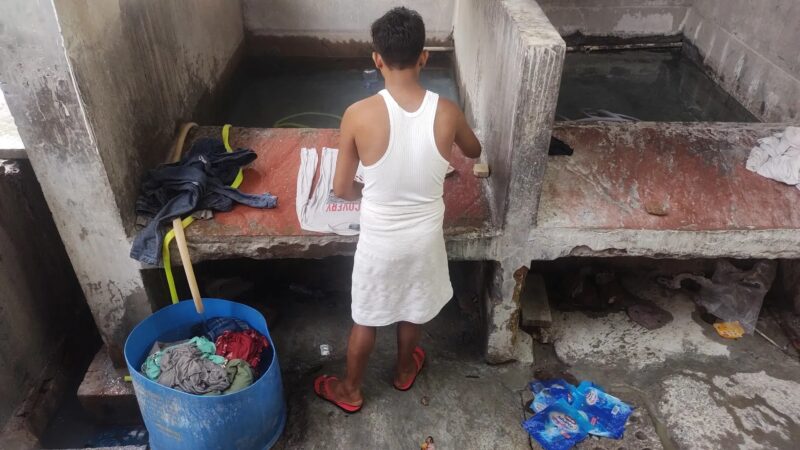
Last month, while BJP leader Kuljeet Chahal alleged that Delhi’s AAP government is depriving NDMC areas of its legitimate share of water, a Delhi government spokesperson said that Haryana is to be blamed for the water shortage in the national capital. “Haryana is not releasing full allocation of water. However, the New Delhi constituency is not being deprived of its share. We urge BJP to ask its Haryana government to release full share of Delhi’s water and not to play politics on water”, the spokesperson stated.
However, the political blame game does not amuse Delhi’s dhobis. “We don’t have enough water supply. The states are fighting over water, and we are bearing the consequences. Water is important for us at home, and for our jobs too. One is where our family lives, and one is where we earn the money for our family. How do we choose who needs the water between the two?”, asks Jamal, a 42-year-old dhobi from Jamia Nagar who has been in this business for 24 years now.
In the settlements in which they live, water tankers have to be called in so that the job gets done. A 1,000-litre water tanker charges Rs 1,200 – 1,500, depending on the level of the water tank – the higher the floor of the tank, the costlier the tanker. Considering the usage of water at dhobi ghats, a 4,000 to 5,000-litre water tanker can suffice for a day.
“We had to call the water tanker three times, which means almost Rs 5,000 – 6,000 was spent cumulatively. Each one of us contributed Rs 500 for the same. Look at what an era we are living in! We have to pay for a natural resource”, says Vishal.
The dhobis cannot delay their work as the delivery of the clothes is promised within a day or two. “Some of them understood the delay following the water shortage. These customers were really helpful and even offered to contribute money for the water tanker. Large businesses can afford these contributions”, says Lalaji.
However, some customers refuse to understand the limitations brought on by the water shortage. “A resident had given 15 kgs of blankets and duvets to clean for an upcoming family event, which was going to take place just three days later. While the delivery was scheduled a day before this family event, it had to be delayed because the water supply was cut”, says Jawahar.
When the customer heard about this, he continued, she was very irate and threatened us saying she will not pay us any amount at all. “It’s not like we deliberately want to suffer a loss”, he remarked.
Lalaji stated that he alone had suffered a loss of almost Rs 5,000 that week which also included the cost of water tankers at work and home. Jawahar had suffered a loss of Rs 2,000 that week.
“During the pandemic, when people were already struggling financially, our houses were demolished by the Delhi Development Authority (DDA). We haven’t recovered from it yet and are still trying to stand on our feet. So, Rs 2,000 loss is a major hit for me and my family”, he said.
What also irked the dhobis a bit was the ambiguous response from NDMC and Delhi Jal Board. “They kept blaming each other, and no proper resolution was given to us. We just wanted to know how much water shortage we are looking at, so that we could plan the budget for the tankers accordingly. We could plan our day and delivery timelines too. Instead, we were left with no updates”, says Vishal.
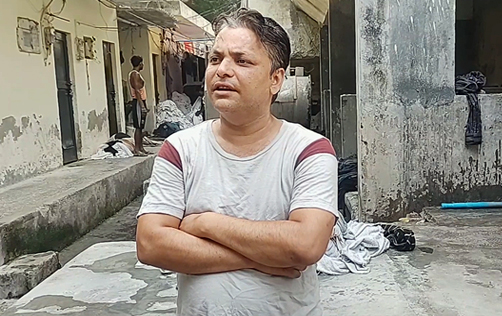
When Patriot contacted Delhi Board officials, they said that the DJB is doing everything in its power to ensure that all parts of the city are supplied with potable water which will be sufficient for a week, at the earliest. The official also stated that dhobi ghats will have to contact respective corporators to get an update on the water situation.
“But the corporators are not doing anything either. They have assured us that water supply at our ghat will resume without any unpredictable cuts, but haven’t given us a tentative date. They blame the Delhi Jal Board instead. That way the corporators don’t have to give us exact information or promise us anything”, says Vishal who, like other dhobis across Delhi, is frustrated with the lack of concern in the government about their plight.
Gender a bar
Amid the chaos of each dhobi ghat across Delhi, one thing stands out. There are no women workers at any of these ghats. “Earlier, we used to have women working at the dhobi ghats. They used to wash and clean the clothes, while the men were in charge of packing and handling the logistics. But things changed when gender dynamics came into the picture”, says Sanjay Kumar, a supervisor at the Jangpura dhobi ghat.
At the Jangpura ghat, while the men are doing the laundry, a woman is ironing fresh clothes in a 10×10 shop outside the ghat gates. A huge pile of neatly ironed clothes rests on the table beside her, and her five-month-old baby is sleeping in the cradle behind her.
“My mother-in-law’s mother used to work at the ghat. And when the money started flowing in, there was a period when women were considering themselves entitled to make house decisions because they were earning too. That irked the elders in the family, according to my mother-in-law. Also, there were incidents where unmarried women were eve-teased by some workers. So, eventually, the home became the only place we could work in, and the dhobi ghat gates were closed for the women”, says the woman.
Like father, like son
Puru, 47, joined the dhobi ghats as an employee when he was 16. His father couldn’t afford his education, and instead, asked him to join the community business, thus keeping family traditions alive. “I look at the men of my age and see them earning better than me, and giving better education to their children. I also wanted that for myself, but it wasn’t in my destiny. My grandfather did this job. He was one of the many people who helped set up this ghat. My father did this job. I am doing this job. And my son, too, is doing this job”, he says.
While the families do not wish to have their children work in dhobi ghats and want to provide them with proper education and jobs instead, meagre pay and poverty do not allow them to change their circumstances. Sons of many dhobis join the ghats at a young age, unable to leave the business for many, many years. Daughters are married off to men within the dhobi community.
“I took loans, worked hard, and educated my son. He has completed his graduation in History from Delhi University. But there are no jobs. And the pandemic added to the unemployment rates too, so he is helping us out temporarily at the dhobi ghat, but I don’t know how long ‘temporary’ means here”, says Jawahar.
Rising competition
While dhobi ghats have managed to survive for more than a hundred years amid evolving technology, it seems that they are losing the battle to new and modern competitors. Laundry services like Wassho, Spotless Wasche, Dhobilite, Pick My Laundry, Laundry Door, U Clean and others have entered the market and offer safe and hygienic laundry at feasible prices.
Vartika, a resident of Lajpat Nagar, says, “I book the service online. They charge according to the weight of clothes, and they pick up and drop off the laundry. Moreover, they also iron and fold the clothes. It is very convenient and hygienic, so I prefer these online services to wash them. In this way, I never have to go to a dhobi ghat on my own.”
She adds that she has seen pictures of dhobi ghats where the clothes are washed and the place is full of trash, dirt and tobacco wrappers. “When they dry the clothes at dhobi ghats, they don’t care if the clothes are touching the ground or not. The whole landscape screams unhygienic to me”, she says.
Lack of clean facilities, unavailability of doorstep services, and limited target audience are putting dhobi ghat’s survival at risk. They need to adapt to the changing needs of consumers and evolving technology. However, they can’t do this without the support of the administration. Until then, the dhobi ghats of Delhi seem to have been left high and dry.
For more stories that cover the ongoings of Delhi NCR, follow us Instagram: https://www.instagram.com/thepatriot_in/
Twitter: https://twitter.com/Patriot_Delhi
Facebook: https://www.facebook.com/Thepatriotnewsindia

